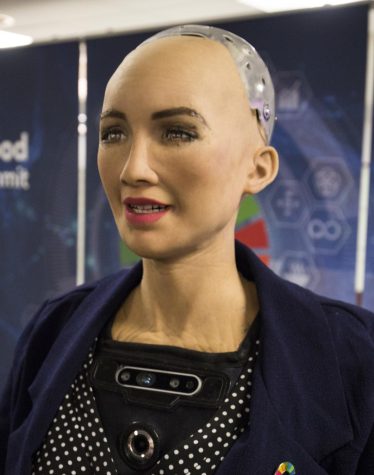The Real Horror of the Uncanny Valley
February 6, 2023
The Real Horror of the Uncanny Valley
You may have only just heard of something called the “Uncanny Valley”, as it has just recently become a recognized proponent in the media. However despite this, the phenomena has a long standing role in human history, and is integral in the fabric of human nature itself. But what might this mean for the future? As we move farther from the finite laws of nature, and closer to something rooted in an innate horror.
Uncanny Valley, according to online newsource IEEE Spectrum, was coined in the 1970’s by professor Masahiro Mori in Tokyo Japan, based upon his observations of the relationship between the appeal of human-like robots, which when the resemblance reaches a certain point, it becomes unsettling. The Uncanny Valley refers to this point in which any feelings of endearment that one might have had are dispelled, in favor of raw feelings of unease, strangeness, and even, fear. To state it concisely, when something is close to resembling a human, but just a little off, it triggers an adverse reaction, rooted in fear.
Mori’s graphical representation of The Uncanny Valley
Photo by Smurrayinchester – self-made, based on image by Masahiro Mori and Karl MacDorman at http://www.androidscience.com/theuncannyvalley/proceedings2005/uncannyvalley.html, CC BY-SA 3.0, https://commons.wikimedia.org/w/index.php?curid=2041097
While it may have been officially branded within the modern era, the phenomenon actually has more distant relatives, even dating back to the year 1818, with Mary Shelley’s, Frankenstein. The novel features scientist Victor Frankenstein, who challenges the dogma of nature, in raising accumulated body parts to life, giving birth to a “monster”. Despite his avid fervor in the process of his creation, upon its fruition, Frankenstein was horrified at the apparition before him. Attributing these raw, and ravaging surges of fear and disgust to the fact that in pieces, Frankenstein was objectively “beautiful”, but together, it was just a little off from “human”. He recognizes specifically, the arid, lifeless, yellow of the monster’s dull eyes, in contrast with the rest of his objectively appealing figure. This occurrence follows in suit with the crux of Mori’s identification, and is a historically significant example of the, thought to be modern, Uncanny Valley.
In recent years, artificial intelligence, or AI, has brought about a modern resurgence of this idea. With technology able to create “deep fakes” of everything from esteemed art, to faces on the street, it subsequently fuels the ever-growing presence of the Uncanny Valley in modern media.
There are endless examples of the phenomenon in recent years, from movies, to robots, to horror tropes. One film in particular that has been attributed to the Uncanny Valley is the children’s holiday movie, “The Polar Express”. Featured in the film are computer generated models of children, which seem, well, a little off. Their movements are uncanny and the resemblance to an actual human is questionable. Along with this, human-like robots have exploded in prevalence, with notable models, according to IEEE Spectrum, being Diego-San, the telenoid, Sofia, and Geminoid HI. Lastly, a specific subset of horror media has exploded, centered around the idea of the Uncanny Valley. This includes “The Mandela Catalogue”, by Alex Kister, and analogue horror.

Humanoid robot, Sofia.
Photo by ITU Pictures from Geneva, Switzerland – https://www.flickr.com/photos/itupictures/27254369347/, CC BY 2.0, https://commons.wikimedia.org/w/index.php?curid=69218227
The Uncanny Valley is an equally fascinating and insightful occurrence, triggering innate fears and discomfort, while at the same time speaking to the ever craving, ever seeking quality of human nature. However, while this can be identified, it is up in the air what this speaks to regarding humanity’s future. In the end, as with much of life, only time will tell.


